American soft power revisited
An update on the global influence of Hollywood.
A little over a year ago, I wrote a post on the declining global influence of American culture as measured by Hollywood’s box office numbers.
For each year, from 2007 to 2024, I calculated the ratio of international box office revenues - excluding Canada and the United States - for the top 200 highest grossing films of that year (numerator) divided by the domestic box office revenues for the same films (denominator). For instance, in 2007, international box office revenue reached $11.45 billion, while domestic box office was $9.36 billion, producing a ratio of 1.22.
I speculated that a decreasing share of Hollywood’s international revenue is a sign of declining American cultural influence in the world, though I did not speculate on the reasons behind the noticeable change in trend that happened around 2017-2019.
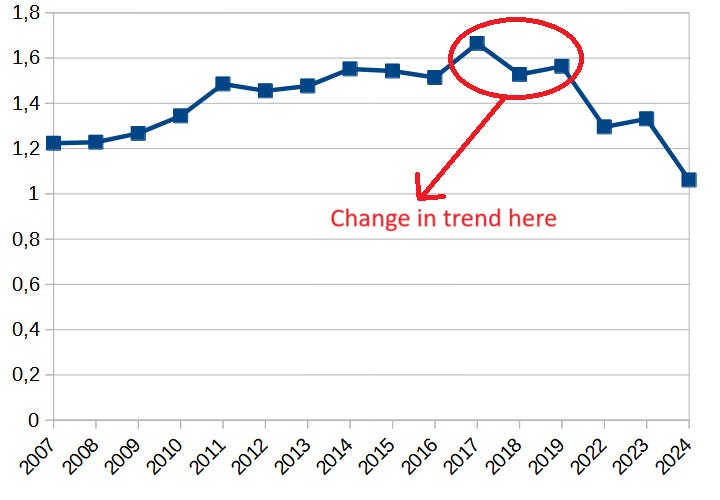
Since I used only partial data for 2024 in my previous post, I could present just two (and a half) data points following the 2017-2019 inflection period to support my hypothesis. So, I’ve decided to update the international-to-domestic ratio chart, now extended to mid-2025, to check whether the declining trend still holds.
And it does1:
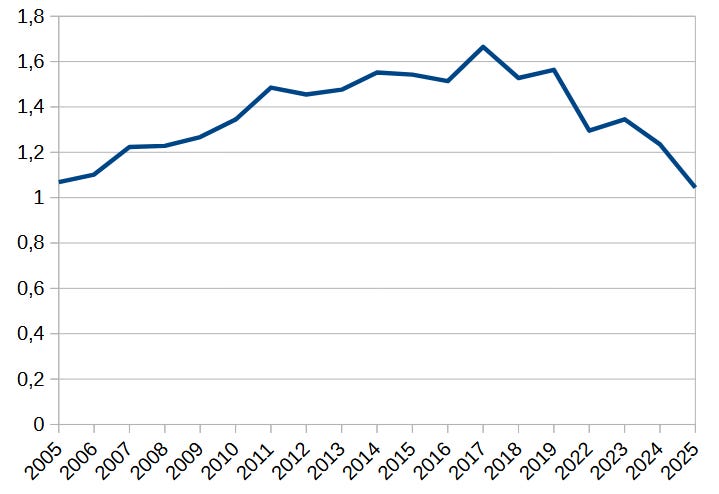
The downward trend seems to intensify from 2024 to 2025, though with the caveat that 2025 data is incomplete.
Notice that I also updated the chart’s starting point to 2005, making the pre-2017-2019 rising trend all the more clear. Given the updated results, I’m now more confident that the post-2019 declining trend is real, yet I haven’t proposed any causes that might explain this phenomenon.
In the previous post I noted that:
…this mild shift in trends might be attributed to a changing selection of movie offerings from Hollywood, rather than a change in the reception of Hollywood films by the wider world. Understandably, audiences desire variety and don’t want to watch the same movie over and over again. Hollywood responds to this desire by changing its offerings, which could consequently explain the changing reception of those movies by audiences.
And I tested whether a changing selection of movies could explain the trend by looking at the international revenue of the Spider-Man movie franchise, a series of films connected by common subjects and a shared cast of characters. If the trend holds for a series of closely related movies, it’s very unlikely to derive from a changing selection of movies being offered by Hollywood, rather than by the shifting preferences of international moviegoers.
The trend does show up in the international revenue numbers of Spider-Man, with an inflection period around 2014-2019, but just to be sure I’ve now analyzed the international box office of the Transformers franchise2 (a new Transformers movie was released after my last Hollywood post).
Here’s the chart showing international revenue (as a share of total) for the eight Transformers franchise films released between 2007 and 2024.
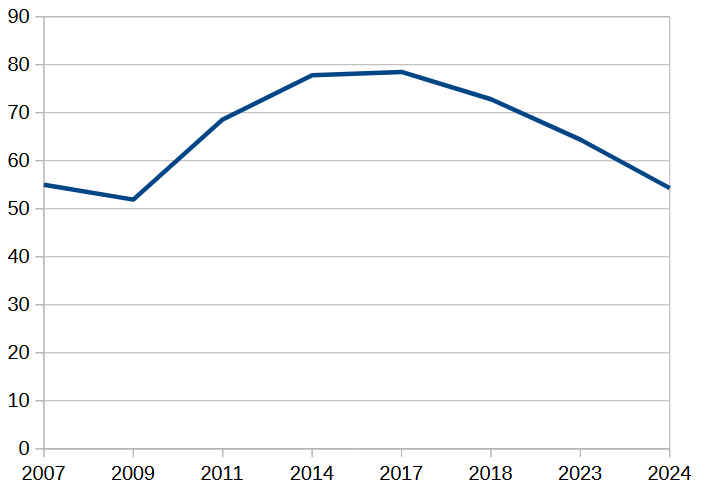
The trend is again very clear, with the inflection point occurring somewhere between 2014 (Transformers: Age of Extinction) and 2017 (Transformers: The Last Knight). At its peak, Transformers’ international revenue approached nearly 80% of the total, but has since dropped to around 55%.
This means the decline in Transformers’ international revenue is very similar to that of Spider-Man, a drop of approximately 25 percentage points. It also makes me question my prior view that the inflection point happened around 2017-2019. I now believe there was a longer inflection period going from 2014 to 2019, and any proposed explanations put forward to account for the change in Hollywood’s international revenue trend should fit with that time period.
So, we have a rising trend in Hollywood’s international box office until the 2014-2019 period, followed by a declining trend after that inflection period. And this last trend appears to be driven by a change in the tastes or preferences of international movie audiences (demand side, not supply side).
Direction downward
While trying to figure out what attributes of a movie have an impact on its international revenue, I compared films with a high international-to-domestic ratio to those with a low ratio and noticed an intriguing pattern: the choice of movie director appeared to have an impact. Based on a small sample of movies, it seemed to me that the national origin of a film’s director has an effect on the international revenue share of the film.
To check whether this is actually true, I looked at the nationality of directors for the top 60 highest-grossing Hollywood movies from 2003 to 2025, identifying them as either American3 or foreign based on their birthplace (as noted in Wikipedia). Then, I calculated the average international box office share for movies directed by Americans and those directed by non-Americans each year, excluding movies not made in Hollywood.
So here’s the chart showing international share for American directors and foreign directors.
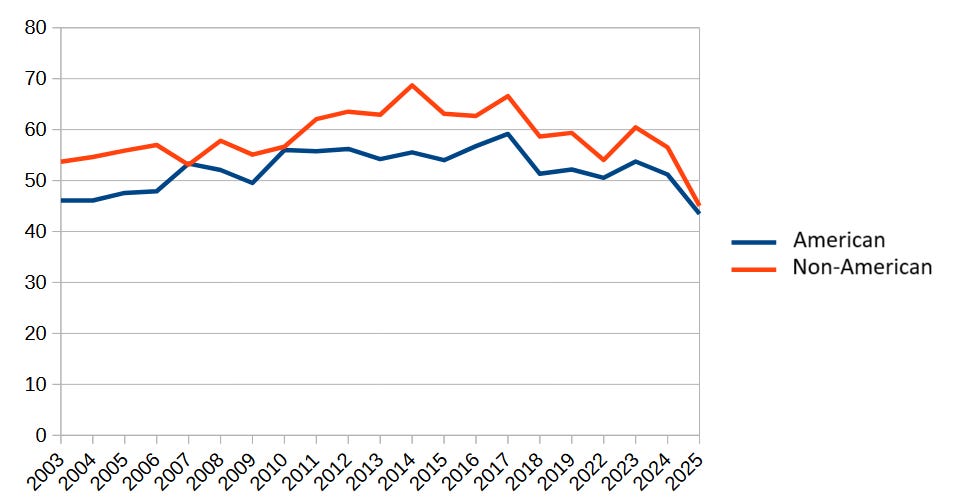
You can see in the chart that the average international revenue share of non-American directors is consistently higher than the international share of American directors (aside from 2007). It seems that non-American Hollywood directors have a certain quality, perhaps in greater abundance than their American peers, that is valued by international audiences and makes their movies more appealing to those audiences. It could also be that American directors are simply less appealing to international audiences.
Furthermore, these are all Hollywood movies, so there’s no reason to think that the source material for these films (script, original book, comic, etc.) is more appealing to American audiences when directed by an American than when a non-American director is in charge4.
Maybe the share of non-American directors has decreased in the last few years?
Less non-American directors working in Hollywood could bring the average international box office share down. But this has not been the case. There is no decrease in the share of non-American directors in recent years that could account for Hollywood’s declining appeal to international audiences5.
This agrees with the decline in the international revenue share for both American and foreign directors during the last few years, as seen in the previous chart. Non-American directors are not immune to whatever is causing the downward trend of international revenue.
Well, that was all I was planning to write about in this post… until I noticed that Hollywood’s international revenue has become a hot topic in the last couple of weeks, due to the release of Superman and The Fantastic Four: First Steps.
For example, renowned American media commentator Angry Joe says6:
Superman BREAKS Records, but FLOPS Internationally - Is $585 Million a Failure?
He then goes on to blame Superman’s low international revenue on: ‘American Way’ Reputation is BAD Right Now. Trump Tariffs Era.
While Norwegian youtuber Andre Einherjar says7:
Marvel’s Fantastic Four Spotlights Superman and DC’s International struggle
And then proceeds to quote Superman’s director James Gunn who said: And it also affects things that we have a certain amount of anti-American sentiment around the world right now. It isn’t really helping us.
Well, assuming that right now refers to the last couple of years, those views8 are wrong.
The decline in international revenue share began in 2019 at the latest, and given this general decline together with the box office trend of the franchises I mentioned earlier (Transformers, Spider-Man), the low international box office of these recent movies is not surprising.
In the case of Superman, we have figures from two previous Superman films released during (or near) the peak years of international share: Man of Steel (2013) had a 56,6% international share and Batman v Superman (2016) got to 62,2%. The current release, with a 42,6% international share, represents a drop of roughly 20 percentage points from the peak, similar to the decline we saw in the other two analyzed franchises.
I also doubt that Hollywood’s declining appeal derives from any conscious preference by international audiences. When pondering whether to watch a newly released movie, most moviegoers probably pay no attention to the director’s national origin. The most likely reason for the higher international share of non-American directors is that they contribute something personal (their culture?) to their work and that something makes their films more appealing to non-American audiences.
You could also argue that American directors contribute something (American culture??) that makes their films less appealing to international audiences.
Culture and tastes are not static. They are something dynamic. And what used to be appealing a decade ago may be less captivating today.
[If you liked this post, you might also like its follow-up: The declining appeal of Hollywood: another piece of the puzzle.]
You can check the footnotes of the previous post for some important caveats.
You can see for yourself the international revenues figures for the Transformers franchise and verify the trends I describe here.
For the purposes of this analysis, Canadians are classified as American, but les Québécois are not American (quelle horreur). Also, I excluded movie directors whose nationality was hard to establish (parse from Wikipedia).
Unless studios purposely put foreign directors in charge of (what they assume is) more internationally appealing material and American directors in charge of American appealing films; which I doubt.
Several other commenters seem to share this view, though I found them harder to quote.


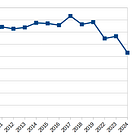
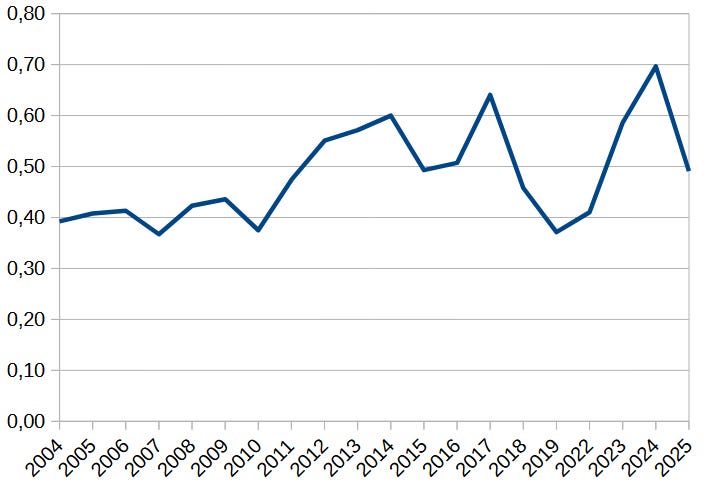
I agree with your general point made in this article. However, the notion that major foreign directors have a je ne sais quoi that the major American directors lack would need to be further specified. As far as I know, the top-grossing films that do historically do well internationally are action and franchise movies where dialogue, social commentary and well-crafted humor are less important, because executing these things well depends a lot on the background and tastes of a specific national audience and can be literally "lost in translation". To most moviegoers, what sways them in watching a film at the cinema is what piece of IP it is based on, not whichever director was hired to direct that specific franchise installment. With that being said, the graph you have does show a trend of international directors outperforming American ones. Perhaps making it to Hollywood for a foreign director requires more initiative and skill than reaching it as an American director.
What a cool post. I really appreciate your updating this with new data!